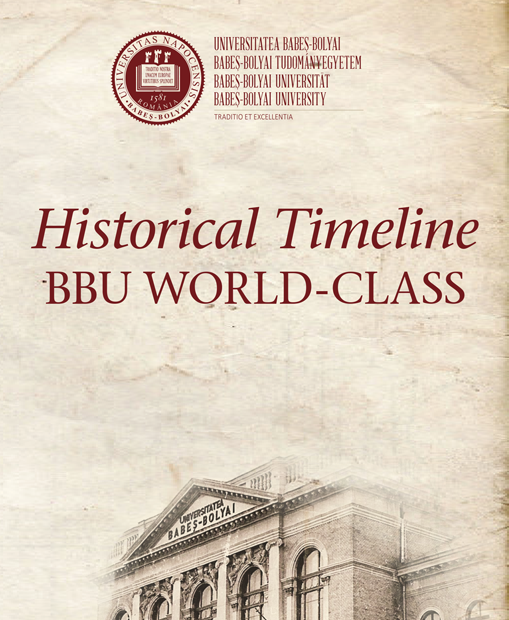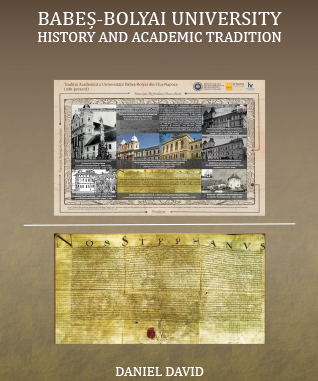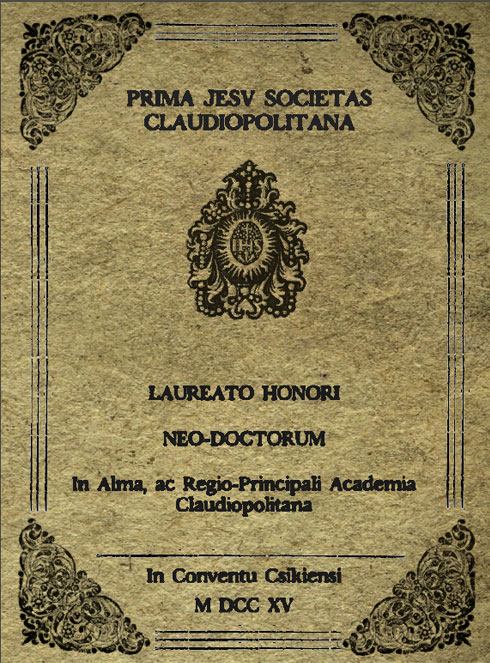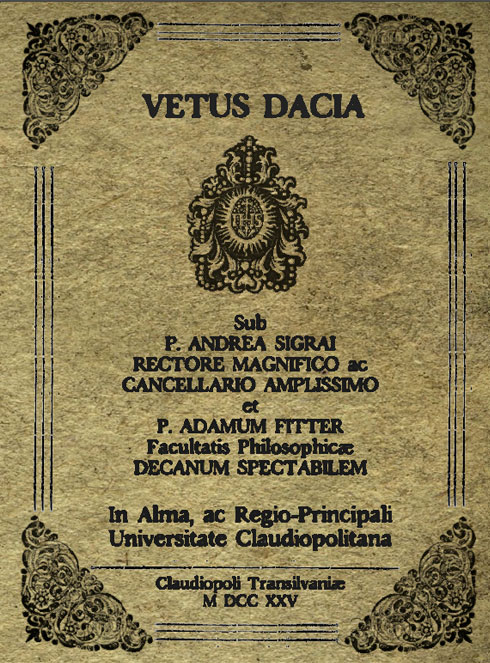Babeș-Bolyai University - short history
16th-19th century - Academia/Universitas Claudiopolitana
The 1578-1607 stage
The history of the academic higher education in Cluj is closely related to the evolution of the city on river Someș. The beginnings of local academic life go down to the 16th century. In 1578, Prince of Transylvania Ștefan Báthory requested permission from Pope Gregory XIII to establish a Jesuit College/Academy in Cluj. The following year, the pope sent to Transylvania the first mission for this purpose, which included Jesuits Ștefan Szántó (Arator), Jakob Wujek, Valentin Ladó, Luigi Odescalchi, Justius Rabbus, Matias Thomány, Wolff Schreck.
The Diploma founding the Major Jesuit College in Cluj (Academia Claudiopolitana Societatis Jesu) was issued by Ștefan Báthory on May 12, 1581, in Vilna (today Vilnius in Lithuania). The founder wished this Major College to be an institution similar to established universities of the time, to include courses in grammar, humanities, rhetoric, philosophy, and theology. In this college Latin, Hebrew, and Greek were taught and graduates could earn the titles of Baccalaureus, Magister and Doctor. The first rector of the college was Jakub Wujek. Latin was the teaching language of the Academy, which had two faculties: Philosophy, followed by Theology.
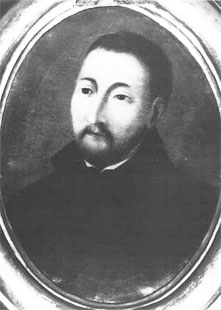
|
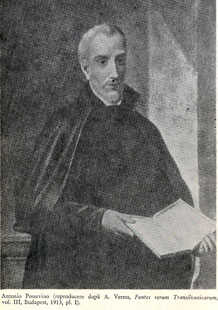
|
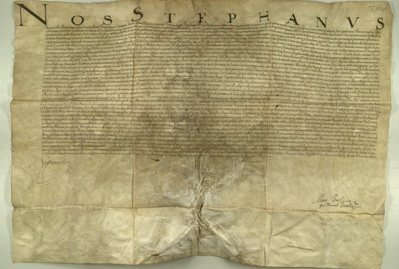
|
In 1583, besides the Major Jesuit College, the Pontifical and Royal Seminary was created (Seminarium Pontificium ac Regium) for Catholic priests. Jesuit diplomat Antonio Possevino was sent to organize the seminary from a pedagogical and administrative point of view. For this reason Antonio Possevino can be considered the spiritual father of the Jesuit higher education in Cluj. The activity of the Major Jesuit College was carried uninterrupted, with brief hiatuses until around 1607 when the Jesuits were banned from Transylvania.
The 1698-1872 period
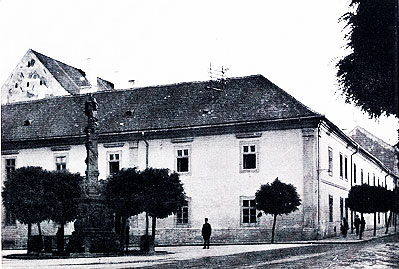
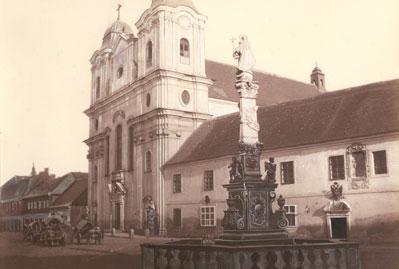
In 1753, Empress Maria Theresa reorganized the Universitas Claudiopolitana as an imperial university, thus weakening the influence of Jesuits. After the dissolution of the Jesuit Order in 1773 the University in Cluj went under the piarists.
In 1784/1786, following the decision of Emperor Joseph II, the University of Cluj became the Royal Academic Lyceum (Lyceum Regium Academicum), having a semiuniversity status (e.g., connecting secondary level of study with the university level of study, by offering training at baccalaureus/magister level, but not at doctor level). It retained three distinct specializations (i.e., departments/faculties/institutes) - philosophy, law, and medicine, while theology (the theological seminary) was moved to Alba-Iulia (where it evolved during the years in an institution with universitary statute, which was integrated in 2007 in UBB). The Universitas Claudiopolitana was followed, after the reorganization of the Lyceum in 1850, by two institutions having a semiuniversity statute: (a) the Surgical-Medical Institute and (b) the Academy of Law (since 1863).Then, starting with 1872, the Royal Hungarian University of Cluj (Franz Joseph University/Cluj Hungarian University) was founded, with teaching in Hungarian, which included the two semiuniversity institutions already existing in Cluj (the main part of the academic tradition of this Hungarian period is shared with the current University of Szeged in Hungary). During the nineteenth century, Cluj had other educational and higher education institutions (with a semiuniversity statute), such as the Reformed College (which included law subject matters) and Unitarian College (which had departments of law and theology).
The 1872-1918 period - The period when teaching at the University of Cluj was in Hungarian (University of Cluj, and after 1881 Royal Hungarian Franz Joseph University)
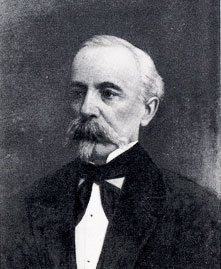
It was only on January 4, 1881 that Francis Joseph I issued the official document founding the university and accepting that it bears his name. The delay was due to the initial state of very poor infrastructure for teaching and research in Cluj. However they gradually initiated extensive construction works for the university. Until 1918, by the end of World War I were built 63 buildings for teaching activities. Among these the most important were:
- The central building of the university ., built in three stages during the1893-1902 period. In neo-Renaissance architectural style and an area of 4,226 m2, it has contained both teaching spaces and rooms with ceremonial functions (e.g. Aula Magna).
- The University Library Building , built between 1906-1909, after the model of the University of Basel Library (Switzerland).
- The complex of buildings of the university clinics , which covered a total of 10,049 m2 of construction, completed in 1903.
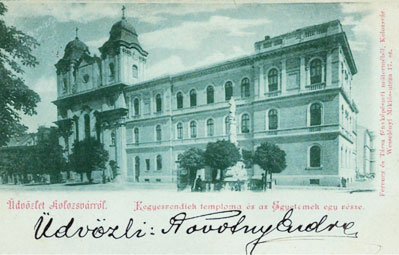
|
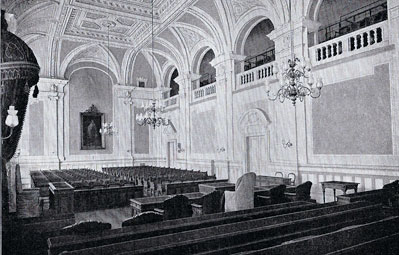
|
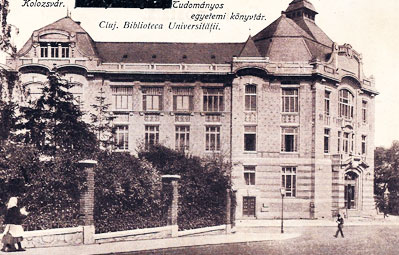
|
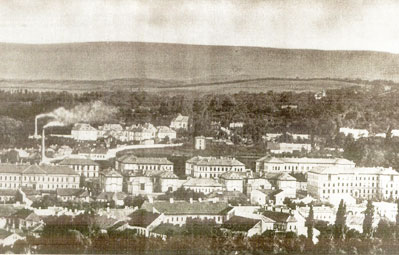
|
The Hungarian university started off with a teaching staff of 40 people for the 40 departments, but until 1919 the number of departments has increased to 61 and that of teachers to 150, along with a large number of secondary teaching staff and support and administrative staff. Many teachers had outstanding scientific achievements recognized internationally. Among them were: mathematicians Lipót Fejér, Alfréd Haar and Frigyes Riesz, geographer Jenö Cholnoky, polihistorian Sámuel Brassai, archaeologist Bélá Pósta, physicists Lájos Martin and Gyula Farkas,etc.
Students enrolled here belonged to all nationalities living in Transylvania (Hungarian, Romanian, German, Hebrew, Armenian, etc.) and all religious denominations (Protestant, Catholic, Orthodox, Greek Catholic, Jewish). Beginning with year 1895 women were allowed to enrol in the University of Cluj. Between 1872-1918 more than 40,000 students studied at the Hungarian University of Cluj and graduation diplomas were granted for 12,000 young people. More than 2,600 of the students were Romanian, with the following personalities standing out: Iuliu Maniu (law student), Iuliu Haţieganu (Medicine), George Coşbuc (Philosophy), Vasile Meruţiu (Natural Sciences), and others.
The 1919-1940 period - The Romanian University in the interwar period ("King Ferdinand I" University)
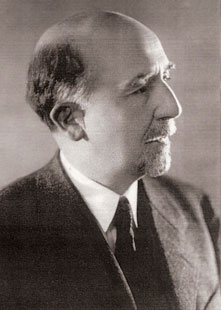
Between January 31 to February 2, 1920 official opening celebrations were held at the Romanian University in Cluj in the presence of King Ferdinand I, Queen Mary, as well as numerous scientific and political personalities, both Romanian and foreign. King Ferdinand I donated 400,000 lei from his own fortune for the establishment of the Institute of National History.
In 1924 the law that officially recognizes the University in Cluj as a legal entity of public law is adopted and published in the Official Monitor.
The first decade of the Romanian academic life in Cluj was marked by the effort to build a performant educational and scientific community, with a view to the Transylvanian context. By 1932, the operating principles of the academic body and university authorities were slightly different from those implemented at the universities of Bucharest and Iași, Cluj enjoying greater autonomy and flexibility. From a scientific and educational perspective the 1919-1932 period is characterized by diversification of subjects studied, as well as creating a large number of institutes, laboratories, departments and seminars, which have contributed to the prestige of the new Romanian university. Now were created: the Institute of Speleology (managed by Emil Racoviţă), the Botanical Garden (director Alexandru Borza), the Astronomical Observatory, the Institute of National History (Directors: Alexander Lapedatu and Ioan Lupaș), Museum of the Romanian Language (coordinated by Sextil Puşcariu), the Institute of Experimental, Comparative and Applied Psychology (founded by Florian Ștefănescu-Goangă), the first Anti-Rabies Institute in Transylvania, the Seminary of Mathematics (headed by Petre Sergescu) and the Seminary of art history, the departments of journalism and social policy, etc.
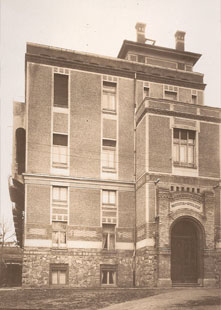
|
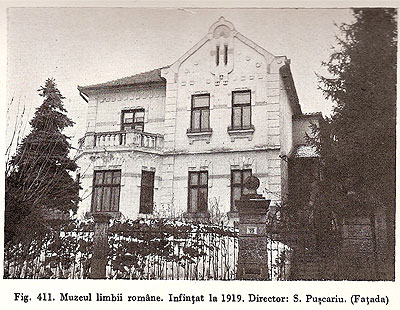
|
In October 1927 the University of Cluj will officially adopt as a homage the name of the first king of Great Romania, becoming known as the King Ferdinand I University, name that it will bear until 1948.
The 1932-1940 period stands out by the standardization of the administrative operation of universities across Romania, Cluj being thus organized like the Universities of Bucharest and Iași. On the other hand, now is the time the great psychologist Florian-Ștefănescu Goangă is rector, a period during which the university underwent significant development. During this interval several major academic infrastructure projects are completed: The Academic College (inaugurated in 1937) and the Sports Park (founded at the initiative of Iuliu Haţieganu) . At this time the Academy of Law of Oradea will be included in the Faculty of Law of the University of Cluj.
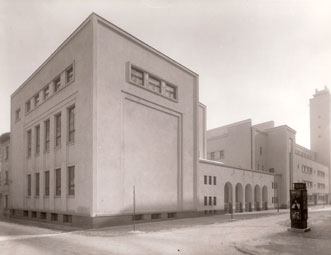
|
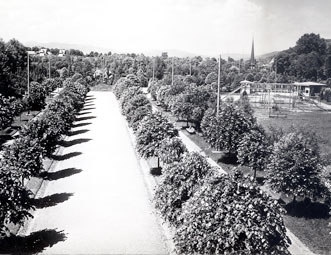
|
University of Cluj during the Second World War (1940-1944)
On August 30, 1940 the northern part of Transylvania, which included the city of Cluj, was conceded to the Hungarian state following the Vienna Arbitration dictate. The impact on the Romanian university was immediate. In September 1940 teachers and students were forced to leave Cluj, looking for a place of refuge in order to continue their teaching and research. After discussing several options, a decision was taken to divide the University of Cluj: The Faculties of Letters and Philosophy, Medicine, and Law moved to Sibiu, and the Faculty of Science was displaced in Timișoara. The first meeting of courses was held on November 10, 1940, both in Sibiu and Timişoara; the displaced university operated without interruption for the duration of the Second World War. As stated by Iuliu Haţieganu, rector during the 1941-1944 period, the mission of the university in the new socio-political and organizational conditions was to preserve and promote Romanian spirituality in Transylvania, the formation territory of the Romanian people.
While "King Ferdinand I" University took refuge in Sibiu and Timișoara, "Francis Joseph" University returned from Szeged and resumed its activity in Cluj with teaching in Hungarian language. This institution had five faculties: Faculty of Law and State Sciences (Law), Faculty of Mathematics and Natural Sciences, Faculty of Arts, Languages and Historical Sciences (Philology), Faculty of Medicine, Faculty of Economics.
The 1945-1948 period - the years of the "painful transition" to communism
The academic life of Cluj was deeply influenced by the geopolitical context at the end of the Second World War. In the spring of 1945, after the reinstatement of Romanian administration over Transylvania, "King Ferdinand I" University returned to Cluj, after its previous displacement to Sibiu and Timișoara. The 1946-1947 years were marked by a massive purge of the teachers of the university, motivated by political and ideological reasons.
In parallel, by Royal Decree no. 407 of May 29, 1945 the "University with Hungarian teaching" was formally established in Cluj. The structure of this new institution included the Faculty of Law and Economics, Faculty of Mathematics and Natural Sciences, Faculty of Letters and History. For a brief period there was also a Faculty of Medicine, which later moved to Târgu Mureș. In December 1945, the Hungarian university in Cluj was called Bolyai University as a tribute to the two Transylvanian mathematicians, Farkas and János Bolyai, father and son.
The 1948-1959 period - parallel universities: Victor Babes University and Bolyai University
On December 30, 1947, the proclamation of the Romanian People's Republic marked the final installation of communism in Romania. As a result, beginning May 1948 King Ferdinand I University of Cluj has officially changed its name in Victor Babeș University.
Following the education reform of August 1948, the structure of both Victor Babeș University and Bolyai University was profoundly altered. Thus, the Faculties of Medicine were completely and irrevocably detached from the composition of the universities and became independent institutions. Starting fall 1948 the departments of Dialectical and historical materialism, Foundations of Marxism-Leninism and Political economy were established. In the fall of 1957 part-time learning (evening) courses and distance learning were created per faculties and departments.
During this period, the following departments functioned with a four-year duration in the Victor Babeș University: Faculty of Mathematics and Physics, Faculty of Natural Sciences, Faculty of Chemistry, Faculty of Geology and Geography, Faculty of Pedagogy and Psychology, Faculty of Philology, Faculty of Philosophy and Faculty of History (which merged into one Faculty in 1954). There was also a Faculty of Legal and Administrative Studies with a three-year duration of studies, which for a short period (1951-1953), functioned jointly with the Faculty of Law of the Bolyai University.
In the same period, Bolyai University included the following faculties: Faculty of Economics, Law and Public Administration, with 18 departments; Faculty of Natural Sciences, with eight departments; Faculty of Mathematics and Physics, with 10 departments; Faculty of Chemistry, with five departments; Faculty of History, with seven departments; Faculty of Philosophy, with four departments; Faculty of Pedagogy and Psychology, with two departments.
Babes-Bolyai University (since 1959)
Following the decisions of the Romania state and party leadership during March-July 1959 a single state university will be created in Cluj by the unification of the Romanian and the Hungarian university.
The new institution, which began its activity in September 1959 was called Babeș-Bolyai University and comprised at the time of its creation six faculties: Faculty of Mathematics and Physics; Faculty of Chemistry; Faculty of Natural Sciences and Geography; Faculty of Philology; Faculty of Law; Faculty of History and Philosophy. The first rector of the Babeș-Bolyai University was professor Constantin Daicoviciu . Upon its foundation Babeș-Bolyai University summed up a total of 702 teaching positions, compared to 782 before unification. In the 1959-1960 academic year the number of students from Babeș-Bolyai was 4,502 of which 3,159 were Romanian, 1,285 Hungarian, 36 German and 22 other nationalities.
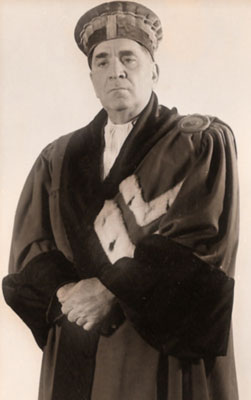
| 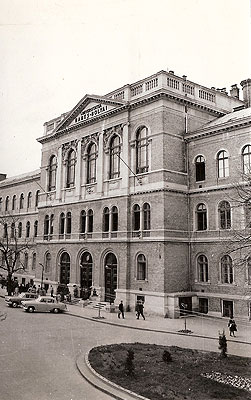
|
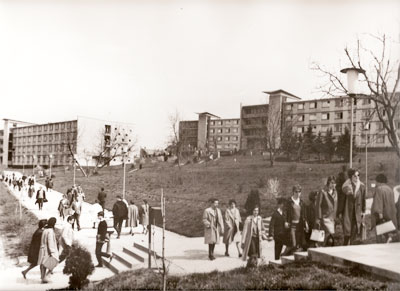
In the 1970-1971 academic year was recorded the highest number of students enrolled: 14,438 people (6,742 in full time learning, 235 in part time learning and 7,461 in distance learning) and the largest number of teachers - 841 people (102 professors, 151 associate professors, 299 lecturers, 198 assistants and 91 interns). Decades eight and nine of the twentieth century represented a difficult period in the Cluj academic life. A gradual restriction of teaching and research activity occurred in line with an internal merging of specializations, disappearance of disciplines (e.g. Psychology), diminishing the scientific contacts with foreign universities, degradation of students and teachers status, etc.
In 1989 Babeș-Bolyai University had a total of 5,619 students and a teaching staff composed of 470 Romanian teachers, 81 Hungarian teachers, 6 German teachers, 10 teachers from other minorities. On December 22, 1989 the Declaration for a new University of Dacia superior was published; it stated the willingness to reorganize the University of Cluj on modern bases, similar to those of the interwar period, following the disappearance of the communist regime.
After 1990, within the new democratic context of Romania, Babeș-Bolyai University underwent a profound transformation. Since 1995 a decision was taken to organize a multicultural university; thus the three major lines of study were created on linguistic criteria: the Romanian line of study, Hungarian line of study, German line of study. Between 1991-2005 an extensive process of faculties diversification took place, either by their detachment from older structures, either by direct establishment. Thus, since the 2006-2007 academic year Babeș-Bolyai University has been operating in a system of 21 faculties. The teaching and research infrastructure has also underwent a substantial development in recent decades; in 1997 one of the largest recent investments was initiated: the building of the Faculty of Economics and Business Administration campus (Photo Campus) (Photo Cube Psychology, etc.). Contacts and collaborations with prestigious academies and universities worldwide were resumed, strong networks of teaching and research were created and numerous scientific cooperation projects were conducted.
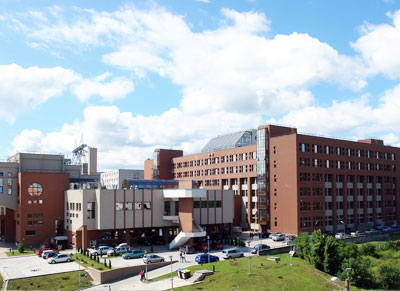
|
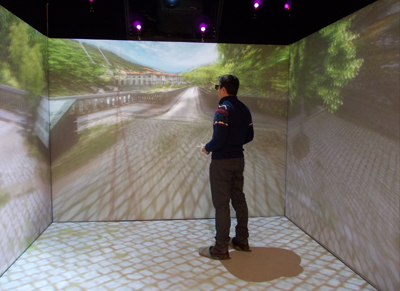
|
By 2015, of the 21 faculties of Babeș-Bolyai University, 17 faculties included activities in Hungarian, and 9 faculties in German. For the 41,690 students enrolled in our institution there were 337 study programmes, undergraduate and master's degree in Romanian, 119 undergraduate and master's programmes in Hungarian and 18 such programmes in German.
Babeș-Bolyai University was recently classified by the line Ministry as a “university of advanced research and education. The institution is situated on prestigious positions internationally; specialized rankings place Babeș-Bolyai University among the world’s academic elite in the field. On a domestic level the University has been ranked in the past years on leading place among the approximately one hundred universities according to the majority of such rankings.
Thus, in the Best Global Universities 2015 ranking Babeș-Bolyai University ranked 560th in the world and in the top released by the Times Higher Education for 2015-2016, Babeș-Bolyai University was the single university in Romania placed in the 501-600 category, at a similar level to other universities of tradition in Central and South-Eastern Europe such as Krakow, Warsaw, Budapest, Bratislava and Ljubljana. It was also in 2015 that Babeș-Bolyai University was nominated for the research excellence award offered for the first time by Scopus (Scopus Research Excellence Award).
According to Webometrics (Ranking Web of Universities) which includes 11,996 universities, Babeș-Bolyai University was ranked 938th place, which makes it the best ranked Romanian university. According to a general ranking for 2016, Babeș-Bolyai University ranked first in Romania.
According to the Report of National Universities Metaranking Exercise of 2016 Babeș-Bolyai University is ranked first in Romania.






